AMD's Zacate APU Performance Update
by Anand Lal Shimpi on September 15, 2010 5:04 AM EST- Posted in
- CPUs
- AMD
- Zacate
- Trade Shows
It’s 12:43AM and I just got back into my hotel room. I spent the past few hours in AMD’s suite a block from IDF trying to get to the bottom of an issue we discovered in our post on AMD’s Zacate GPU performance numbers earlier this week.
Let’s recap. Zacate is AMD’s 18W APU aimed at the mainstream notebook market (~$500 notebooks). The APU features a pair of Bobcat cores and a Cedar-class AMD DX11 GPU. Spending some time with the physical Zacate package, it seems to have a single 64-bit DDR3 memory interface ala Atom. Unlike Atom however, both the Bobcat cores and the DX11 GPU should be relatively high performance.
Earlier this week, AMD showed us the first public demonstration of Zacate. In its suite were two systems: a Zacate test platform and a Core i5-M 520 notebook from a major OEM. Both systems were configured with 4GB of memory and were running the 64-bit version of Windows 7 Premium.

AMD's Zacate
The first demo we saw on Monday was the system running City of Heroes. In CoH Zacate managed to reach frame rates around 2x of what we saw on the Core i5-M 520. AMD also ran through a number of IE9 performance tests including the Psychadelic HTML5 benchmark and the Amazon Shelf test. In both of those tests, the Zacate platform was significantly faster than the Core i5-M 520. And it was those IE9 tests that seemed suspect.
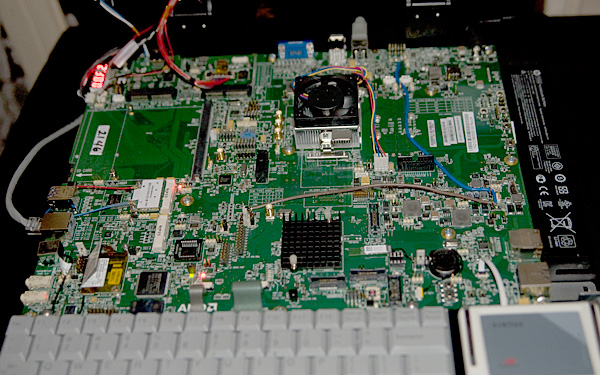
The Zacate test platform
I didn’t think much of it at first, but Zacate managed a ~10x performance advantage in the IE9 Psychadelic benchmark. While Zacate should have a higher performance GPU, it shouldn’t be that much faster. Something was amiss.
I borrowed a Core i5 notebook from Intel (we are at IDF after all) and ran the same tests on it. The performance was much better than what I saw in AMD’s suite. I went back to AMD to find out exactly what was going on.
I brought up the issue and AMD immediately began looking into it. AMD used the latest drivers made available for this particular Core i5 notebook on the manufacturer’s website. Those drivers were version 2104 dated 3/31/10. AMD explained that these systems were configured about a month before launch and they were using the latest drivers available on the manufacturer’s website at the time. This particular OEM didn’t offer a newer version of the Intel HD Graphics drivers via its website. To make matters worse, Intel’s updated HD Graphics driver wouldn't install on the notebook. Some notebook OEMs prefer to provide their own display driver updates. In those cases, the Intel HD Graphics drivers available from intel.com won’t install. Despite only having a single Core i5 machine for all of its press demos for tomorrow, AMD agreed to let us manually install the driver (extract the driver and force device manager to update the driver manually) on the i5 system.
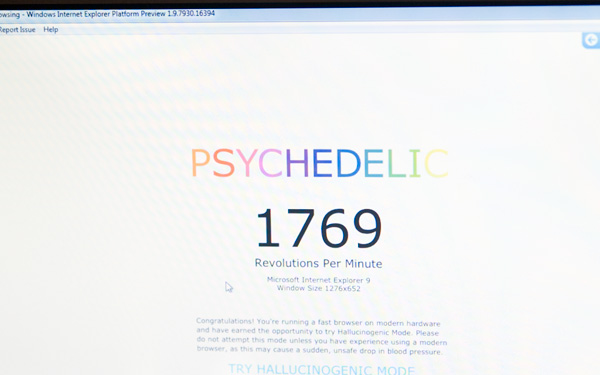
Zacate
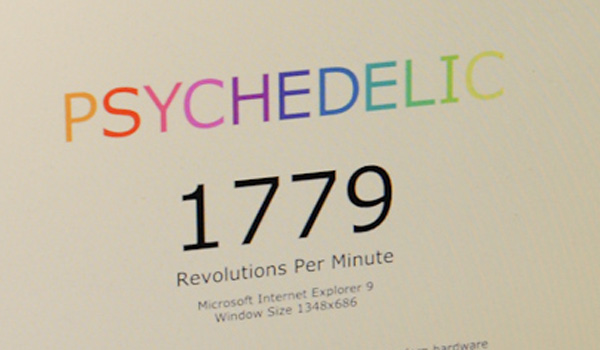
Intel Core i5-M 520 w/ latest drivers
The updated driver brought the IE9 performance tests to parity with Zacate. In fact, it looks like the IE9 benchmark doesn’t scale too far with GPU performance (apparently discrete cards don’t score much higher than what we’ve seen here).
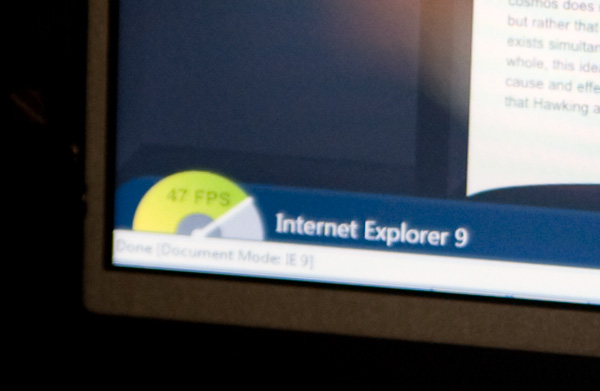
Zacate
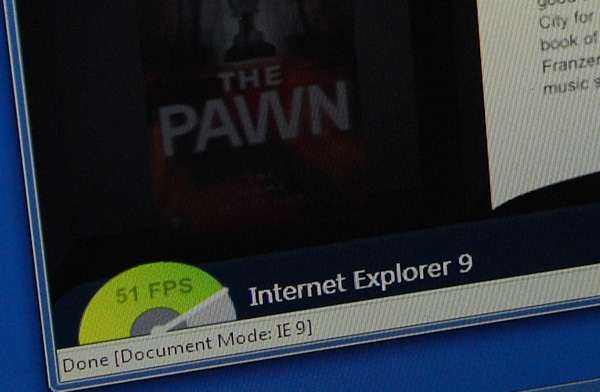
Intel Core i5-M 520 w/ latest drivers
At this point we had an issue. The IE9 benchmarks AMD was showing off weren’t an accurate comparison of the two architectures. While valid for the only driver revision supported on this particular Core i5 notebook, the scores weren’t valid for a Zacate vs. Core i5 architecture comparison. AMD wanted to make sure there was no confusion about the GPU performance potential of Zacate so it allowed us to install whatever we wanted on both systems to validate the GPU performance we had seen.
Take a moment to realize exactly what just happened here. In an effort to convince us (and you) that it had nothing to hide and didn’t deliberately attempt to stack the deck, AMD gave us full access to the Zacate platform to do whatever we wanted. AMD wanted us to be completely comfortable with the Zacate comparison.
We downloaded the Batman Arkham Asylum demo off of Steam and loaded it on both the Zacate and Core i5 systems (AMD originally bought two copies of the full game via Steam only to find that SecureROM kept crashing on the Zacate platform at launch, way to go SecureROM). We set both machines to 1024 x 768 at high quality settings. We played through the beginning of the demo as well as FRAPSed a short walk through the first room you’re dropped in:
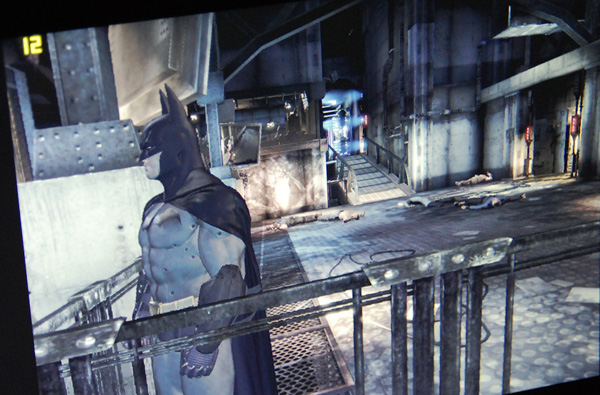
Batman, Core i5-M 520
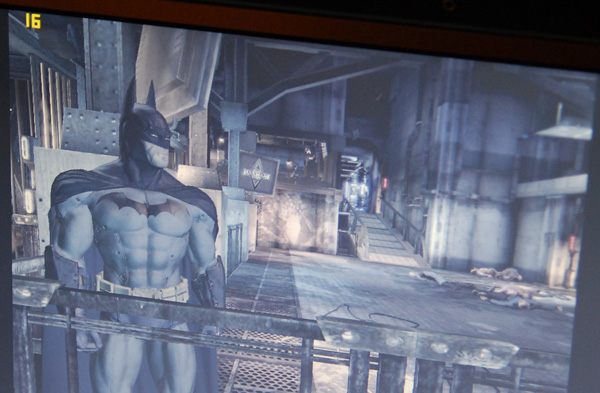
Batman, Zacate
| Batman Arkham Asylum, FRAPS Walkthrough, 1024 x 768 High Quality | ||||
| AMD Zacate | Intel Core i5-520M | |||
| Batman | 16.5 fps | 11.3 fps | ||
The actual gameplay was noticeably quicker on Zacate and the numbers show a 45% performance advantage. This is huge. To sanity check that data we fired up City of Heroes on both machines and played around with them. The frame rate varied depending on where you were in the scene and we saw peak frame rates close to the 2x advantage repeated in our second pass with updated Intel drivers. Note the differences in contrast below are due to the vastly different screens the two systems were using.
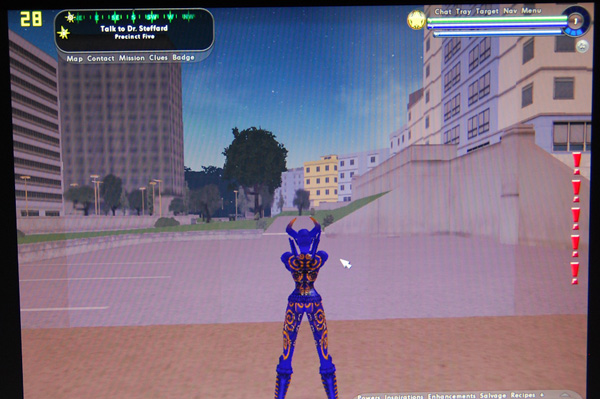
City of Heroes, Core i5-M 520

City of Heroes, Zacate
We put together a quick FRAPS walkthrough to show how the average frame rate improved:
| City of Heroes, FRAPS Walkthrough, 1024 x 768 Low Quality | ||||
| AMD Zacate | Intel Core i5-520M | |||
| City of Heroes | 39.6 fps | 25.5 fps | ||
On average we saw a 55% improvement over the Core i5 system.
AMD wanted to highlight the DirectCompute performance of Zacate and let us publish the first results from the platform running the N-Body Simulation benchmark:
| N-Body Simulation, DirectCompute Performance | ||||
| AMD Zacate | Intel Core i5-520M | |||
| N-Body Simulation | 23 GFLOPS | 8.8 GFLOPS | ||

AMD views Fusion as a way to not only bring better gaming performance to the market, but also enable a lot of new GPU compute applications. Remember that Zacate and Ontario are going into systems priced at around $500 or less. With this type of GPU compute in the entry level, it’s only a matter of time before developers start to do something with it.
The Zacate GPU performance we’re seeing here today is completely unoptimized as well. The clocks aren’t final, drivers aren’t fine tuned and although we’re close to release, there’s still potentially more performance on the table.
It’s very rare for any public company to make an on the spot decision to let us benchmark and publish test data of an unreleased part without having ever seen it before. The first time the AMDers in the suite saw Zacate running Batman was when we installed it. To be honest, it was probably the most open and flexible I’ve ever seen AMD be. I knew if the IE9 numbers changed that it would call the City of Heroes numbers into question. By allowing us to rerun everything as well as add an additional title (one that we’ve used more recently) AMD handled the situation perfectly.
At the end of the day my take on Zacate (and Ontario) hasn’t changed: these two APUs have the potential to make the low end netbook/notebook market interesting again.










96 Comments
View All Comments
Jamahl - Wednesday, September 15, 2010 - link
What do you expect AMD to walk up to intel and say "Give us one of your unreleased Sandy Bridge systems so we can benchmark our new chip against it"?Dear oh dear.
djgandy - Wednesday, September 15, 2010 - link
No, but there were some numbers for SB released the other day which could have been used.So your logic is if you can't make the right comparison, just make any comparison?
Jamahl - Wednesday, September 15, 2010 - link
Yes that could have been done, but then we'd have an idea of its performance vs SB at low resolution.That's the kind of thing Anand would like to keep back until the full review, don't you think?
Shadowmaster625 - Wednesday, September 15, 2010 - link
Do you have any idea how much Intel is going to be charging for a <20W SB? If it is less than $200 for the chip alone, I'll give you a cookie. Intel will sell nothing as cheap as zacate, unless it is an atom.lwatcdr - Wednesday, September 15, 2010 - link
"Also SB Will come in very low power parts (sub 20W) that target the ultra mobile laptop segment."Will come.
When it show up I am sure it will be tested.
Thing is that the real apples to apples test with this would be with Cedar Trail but I do not think they are available yet.
The test with the i5 is to show that it can not just bet an Atom but i3 and i5.
Frankly this APU looks great. It will be cheap and probably good enough for 90% of the people out there.
Frankly as a consumer which CPU/APU is best really doesn't matter as much as which is best for x dollars.
mino - Wednesday, September 15, 2010 - link
Actually I would not be surprised to see a whole bunch of mATX MAINSTREAM boxes sooner than later.Without the stupid Intel restrictions, despite whose Atom desktops sell, it would not take much time for the Taiwanese juggernauts to flood the market ...
justjc - Wednesday, September 15, 2010 - link
Considering that the current last generation, the Core2Duo designs, resides in the ~$500 market, the one Zacate will attack, I would say the comparison has merit for comparing the likely competition in 2011.MonkeyPaw - Wednesday, September 15, 2010 - link
I'm wondering if we have enough info from those demos to guesstimate the number of SPs in Zacate. 200?Also, I bet the single channel IMC isn't as big a deal since it's DDR3 bandwidth, and the GPU is getting direct CPU/cache access.
Sandy Bridge aside, it looks like netbooks just got a huge kick in the pants! :D
mino - Wednesday, September 15, 2010 - link
Give or take 10 :)derek85 - Wednesday, September 15, 2010 - link
Based on the info I believe it would be 80 SP, since it packs a Cedar core. And from the performance numbers it looks very much like so.